Melanochromis
Member
- Messages
- 249
- Location
- Bangkok, Thailand
I wasn’t sure if people would be interested in the dwarf cichlid scenes in Thailand. But perhaps some do. So, I’m writing this article about one of our recent developments this year, which I think is pretty exciting. It’s about a fish competition.
A Competition?
Yeah, you heard it right! It’s a competition for dwarf cichlids.
In Thailand, fish shows are lively and big events. And fish competitions are the highlight of a fish show. In each year, there are three big fish shows in Thailand, and all three would host competitions for goldfish, bettas, guppies, discuses, flowerhorns and planted tanks. Arowanas, koi, clownfishes and freshwater rays get their competitions too, but not in all three shows. Malawi cichlids used to have their events for at least a decade before ending up being replaced by flowerhorns. Killifishes and pearl gouramis each had one-time competition that was not continued.
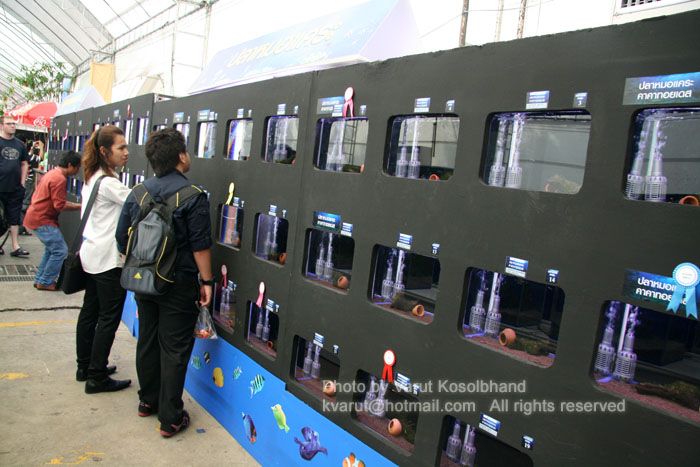
You can probably guess now that competitions are a big thing in for the Thai fishkeeping hobby and related businesses. They attract tons of people, including those who never even kept a fish!
Earlier this year, organizers of the fish shows started to ask us dwarf cichlid hobbyists if we wanted to have a competition. We knew from the start that dwarf cichlids are not exactly the perfect fish for competition, but still this would be the greatest ever opportunity to popularize the fish we love. So, in response, we formed the Dwarf Cichlid Club of Thailand and joined the fish shows under the club’s name.
The fish shows expect us to follow their structures and preference. They don’t like “open category” for competition. So, we had to pick species, leading to our eventual decision to choose rams and cacatuoides. Rams are popular, colorful and always flaring to spectators, which makes it the best crowd-pleasing dwarf cichlid ever. Cacatuoides can hide sometimes and are not as showy, but we hope that they will generate interest in the Apistogramma species.
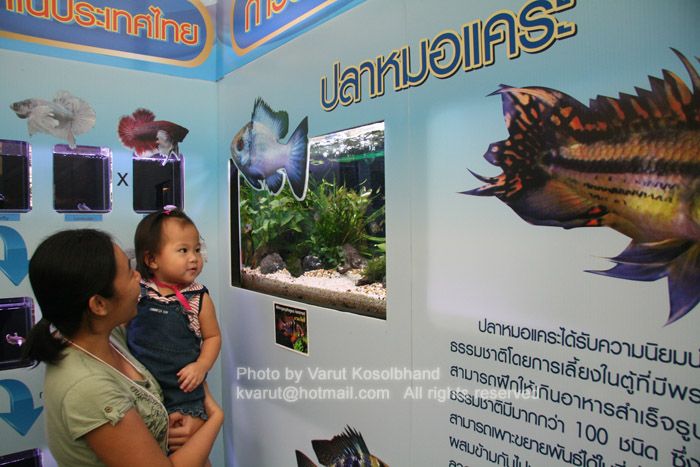
We decided that the dwarf cichlids would be competing in pairs, not individuals, to differentiate them from other fish. This unfortunately makes it more difficult for fish owners who have to make sure that their pairs are compatible enough to be in one small tank for over a week at the show.
While other competition fish are shown in bare tanks, we chose to put substrate, driftwood, mosses, small flower pots, and dither fish in our tanks to show the public how dwarf cichlids should be kept. This is a lot of work for us. It takes nearly half a day to set up the tanks!
In order to make sure the public will learn something, we asked the organizers to put up a small educational exhibition on dwarf cichlids with two show tanks, one for rams and another for Apistogramma and Dicrossus species. It is unfortunate that the exhibition and competition tanks were not next to each other, but we couldn’t really complain. It was better than not having an exhibition at all.

The next step is getting enough people to send their fish to the competitions. The organizers demanded that there must be at least 15 pairs for each species. Otherwise, they would cancel the competition. This requirement gave us a lot of headache, mainly due to the cacatuoides shortage in the market that happened unexpectedly. People wanted to participate, but they couldn’t find any fish to send. We nearly lost our hope, but with help from breeders, importers and shops, we eventually got enough fish just in time.
We ended up having 24 pairs of cacatuoides and 20 pairs of rams in the competition. This pleased the organizers very much and they immediately invited us to join their next event!
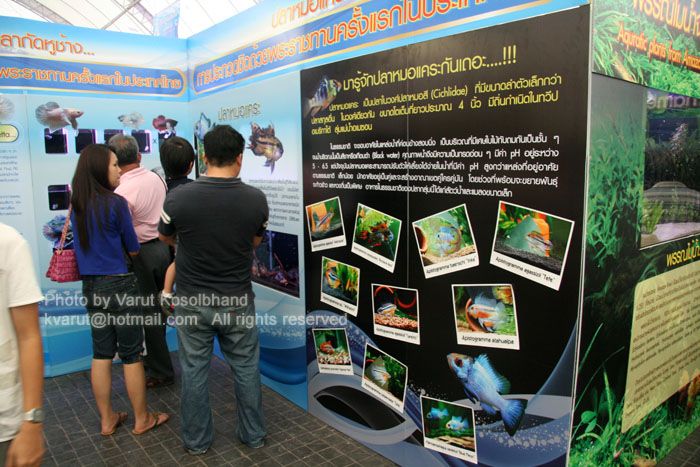
The judging part was really fun. Earlier, we had established the club’s breed standards for rams and cacatuoides, which received reviews and greenlights from the breeders and hobbyists. There were five judges, consisting of two officials from the Department of Fishery, two respected hobbyists from the club and a well-known cichlid guru in Thailand.
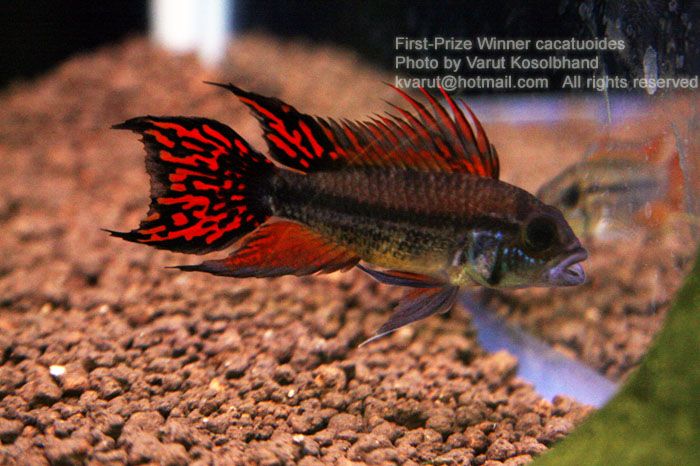
Cacatuoides was easier to judge. After eliminating those with serious flaws such as various deformities, there were only a few pairs left. A pair stood out with the male showing the outstanding color and pattern, especially on the caudal fin, while the female was already guarding her eggs in the pot. This pair went on to become the first-prize winner. The owner of this pair was rather a new but enthusiastic hobbyist, who drove several hours to Bangkok every week to check out fish shops here.

Judging rams, however, took much longer. Contrary to what westerners might believe, the Thai-bred rams these days are very healthy, big and extremely colorful. They all were of very high caliber and the judges had to examine each of the pairs very closely in order to pick the best one. Finally, we found the winning pair, which was owned by a veteran cichlid fan.
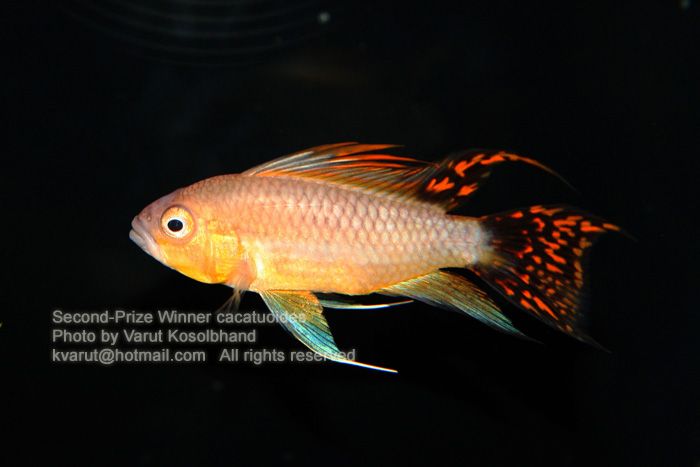
Both the cacatuoides and ram winners received their trophy cups from Princess Chulabhorn Walailak of Thailand, who personally presided over the award ceremony. Her Royal Highness is a hobbyist herself and has written books on angelfish and discus breeding. The award ceremony was in the television news that evening.

All in all, I think the whole fish competition thing was worthwhile. We triggered an interest in many people. The number of newbie hobbyists surged right away, while some veterans returned. Nearly all major Thai-language fish magazines reported the competition results with pictures of winning pairs. The fish shops and importers seemed to be very happy too, and the Department of Fishery is now interested in promoting dwarf cichlids.
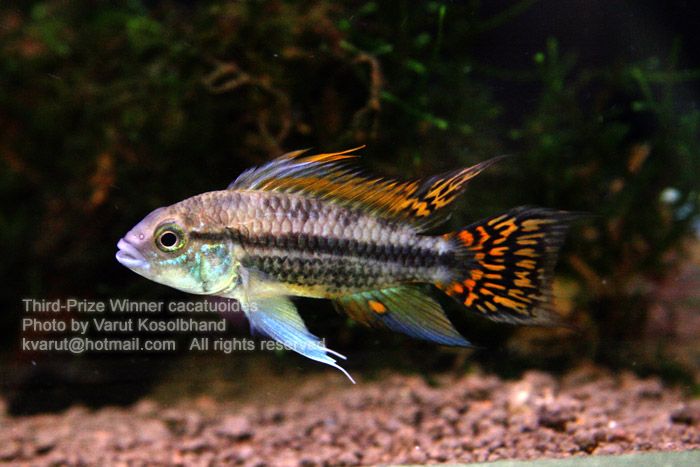
There is room for improvement. We ran into various obstacles, some of which we couldn’t overcome, and the whole process to plan and hold a fish competition was very exhausting to us all. But in general, I think we are proud of what we did.
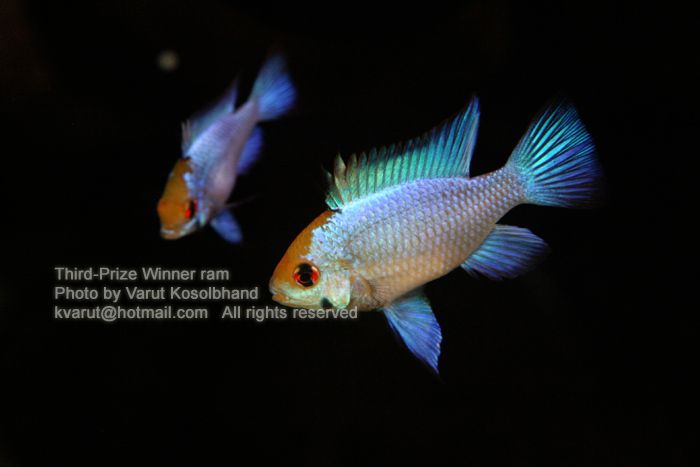
Thank you very much for reading. This article has turned out to be a bit long. But I hope our experience will be useful for some of you.
Cheers to All Who Love Dwarf Cichilds,
Varut K.
A Competition?
Yeah, you heard it right! It’s a competition for dwarf cichlids.
In Thailand, fish shows are lively and big events. And fish competitions are the highlight of a fish show. In each year, there are three big fish shows in Thailand, and all three would host competitions for goldfish, bettas, guppies, discuses, flowerhorns and planted tanks. Arowanas, koi, clownfishes and freshwater rays get their competitions too, but not in all three shows. Malawi cichlids used to have their events for at least a decade before ending up being replaced by flowerhorns. Killifishes and pearl gouramis each had one-time competition that was not continued.

You can probably guess now that competitions are a big thing in for the Thai fishkeeping hobby and related businesses. They attract tons of people, including those who never even kept a fish!
Earlier this year, organizers of the fish shows started to ask us dwarf cichlid hobbyists if we wanted to have a competition. We knew from the start that dwarf cichlids are not exactly the perfect fish for competition, but still this would be the greatest ever opportunity to popularize the fish we love. So, in response, we formed the Dwarf Cichlid Club of Thailand and joined the fish shows under the club’s name.
The fish shows expect us to follow their structures and preference. They don’t like “open category” for competition. So, we had to pick species, leading to our eventual decision to choose rams and cacatuoides. Rams are popular, colorful and always flaring to spectators, which makes it the best crowd-pleasing dwarf cichlid ever. Cacatuoides can hide sometimes and are not as showy, but we hope that they will generate interest in the Apistogramma species.

We decided that the dwarf cichlids would be competing in pairs, not individuals, to differentiate them from other fish. This unfortunately makes it more difficult for fish owners who have to make sure that their pairs are compatible enough to be in one small tank for over a week at the show.
While other competition fish are shown in bare tanks, we chose to put substrate, driftwood, mosses, small flower pots, and dither fish in our tanks to show the public how dwarf cichlids should be kept. This is a lot of work for us. It takes nearly half a day to set up the tanks!
In order to make sure the public will learn something, we asked the organizers to put up a small educational exhibition on dwarf cichlids with two show tanks, one for rams and another for Apistogramma and Dicrossus species. It is unfortunate that the exhibition and competition tanks were not next to each other, but we couldn’t really complain. It was better than not having an exhibition at all.

The next step is getting enough people to send their fish to the competitions. The organizers demanded that there must be at least 15 pairs for each species. Otherwise, they would cancel the competition. This requirement gave us a lot of headache, mainly due to the cacatuoides shortage in the market that happened unexpectedly. People wanted to participate, but they couldn’t find any fish to send. We nearly lost our hope, but with help from breeders, importers and shops, we eventually got enough fish just in time.
We ended up having 24 pairs of cacatuoides and 20 pairs of rams in the competition. This pleased the organizers very much and they immediately invited us to join their next event!

The judging part was really fun. Earlier, we had established the club’s breed standards for rams and cacatuoides, which received reviews and greenlights from the breeders and hobbyists. There were five judges, consisting of two officials from the Department of Fishery, two respected hobbyists from the club and a well-known cichlid guru in Thailand.

Cacatuoides was easier to judge. After eliminating those with serious flaws such as various deformities, there were only a few pairs left. A pair stood out with the male showing the outstanding color and pattern, especially on the caudal fin, while the female was already guarding her eggs in the pot. This pair went on to become the first-prize winner. The owner of this pair was rather a new but enthusiastic hobbyist, who drove several hours to Bangkok every week to check out fish shops here.

Judging rams, however, took much longer. Contrary to what westerners might believe, the Thai-bred rams these days are very healthy, big and extremely colorful. They all were of very high caliber and the judges had to examine each of the pairs very closely in order to pick the best one. Finally, we found the winning pair, which was owned by a veteran cichlid fan.

Both the cacatuoides and ram winners received their trophy cups from Princess Chulabhorn Walailak of Thailand, who personally presided over the award ceremony. Her Royal Highness is a hobbyist herself and has written books on angelfish and discus breeding. The award ceremony was in the television news that evening.

All in all, I think the whole fish competition thing was worthwhile. We triggered an interest in many people. The number of newbie hobbyists surged right away, while some veterans returned. Nearly all major Thai-language fish magazines reported the competition results with pictures of winning pairs. The fish shops and importers seemed to be very happy too, and the Department of Fishery is now interested in promoting dwarf cichlids.

There is room for improvement. We ran into various obstacles, some of which we couldn’t overcome, and the whole process to plan and hold a fish competition was very exhausting to us all. But in general, I think we are proud of what we did.

Thank you very much for reading. This article has turned out to be a bit long. But I hope our experience will be useful for some of you.
Cheers to All Who Love Dwarf Cichilds,
Varut K.